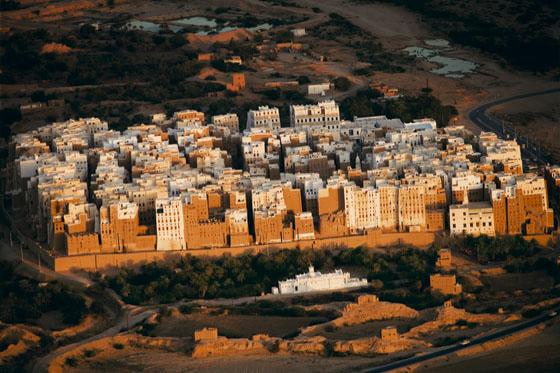
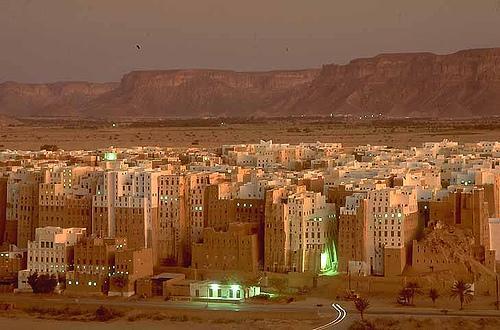
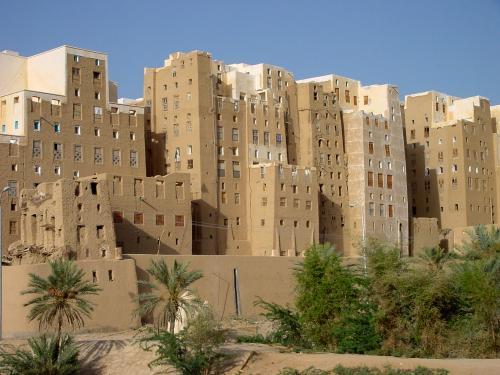
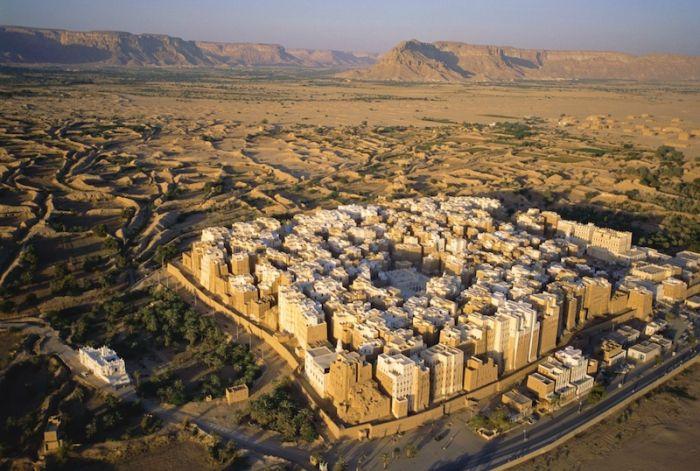
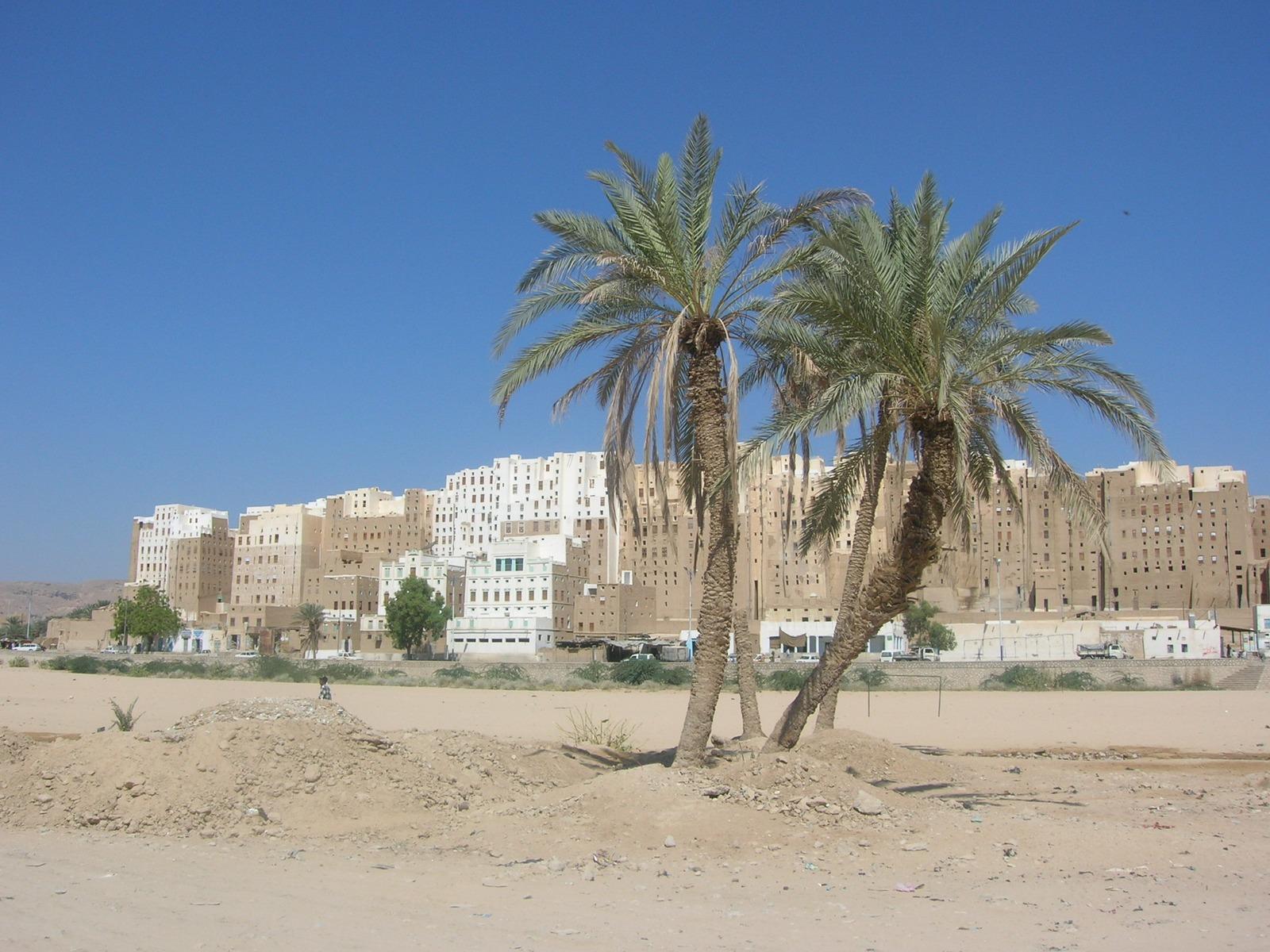
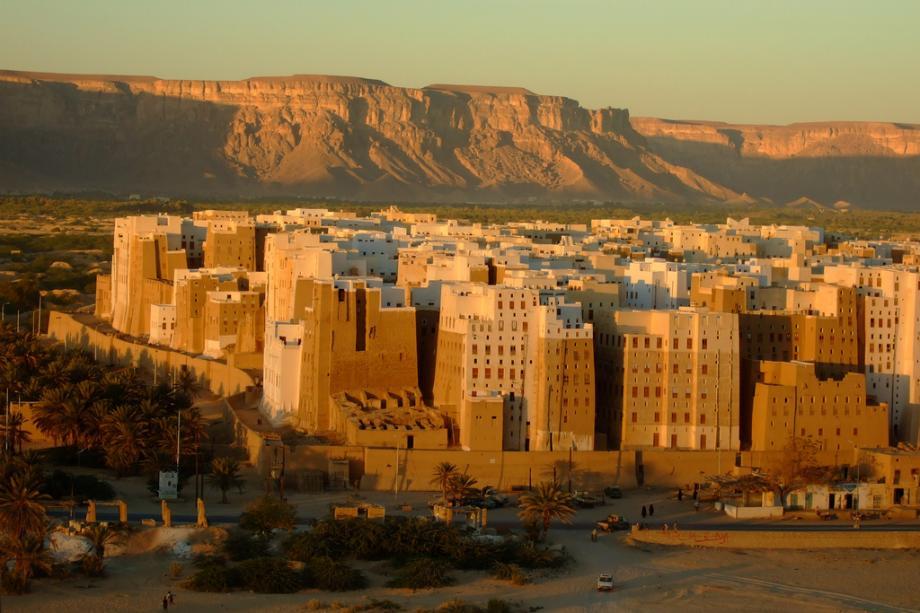
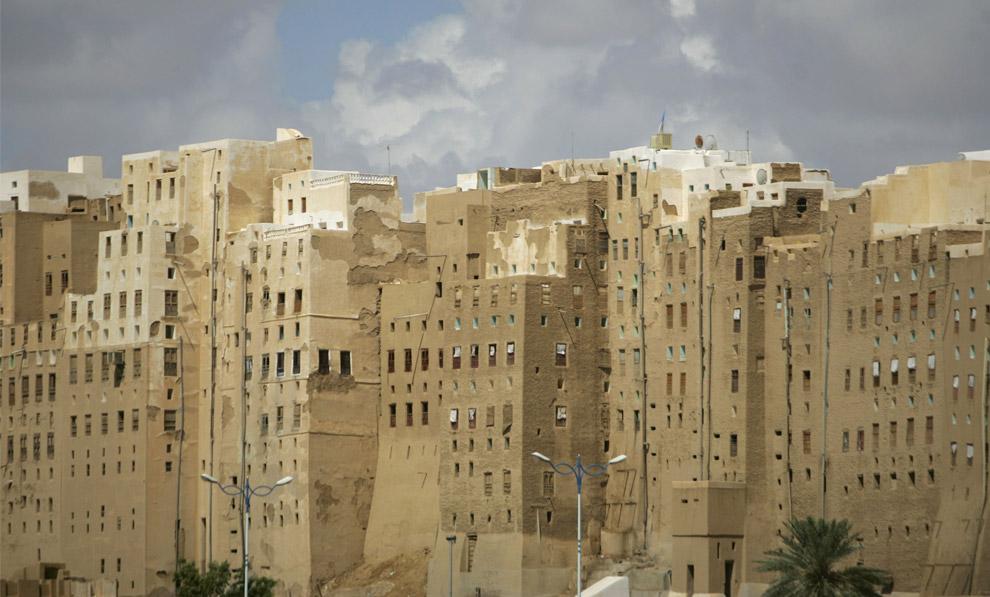
A hundred miles inland from the South Arabian port of Mukalla, in a fertile wadi near the westernland of the Empty Quarter, stands the improbable city of Shibam. Its buildings are skyscrapers of sun-baked clay, towering up to twelve storeys high-in former time an impregnable defence against the marauding Bedouin of the desert.
When you stand facing Shibam, in South Arabia, it seems a mystery that you did not see it first miles away, this colossus of a town whose houses are ten or twelve storeys high. But it is only when you have come through the wadi to the oasis of Shibam that it emerges, unexpectedly and preposterously, as though it had sprung from the ground that very moment. It is a little while before you realize that this miracle, too, has its explanation: the yellow, brown and white colours of the houses merge to such an extent with the sand and the surrounding mountains that in certain lights the town is almost invisible.
Shibam is in every way a fantastic town – a New York of the desert which existed centuries before New York was built, paradoxically, the name Shibam means young or new. Its houses rise from the sand in huge, rectangular blocks; it looks like hundreds of desert forts, and indeed every one of the buildings is in itself an almost impregnable fortress. Unlike many other Arab town, Shibam has no town wall; but the massive outsides of the houses from a closed shell which it would be practically impossible for hostile Bedouin tribes to penetrate. The openings on to the outside world are embrasures and many feet high; only the upper storeys have windows. The few gates from the only possible entrance to the town. The steep outside face of the building, looking towards the desert, is supported below by a sloping wall, or by buttresses; and though all these tall houses are built of sun-baked clay and not of concrete, they appear more solid than the skyscrapers of New York.
There is good reason why each of these houses, both in Shibam itself and it the oasis, should be a separate stronghold, for in times past many feuds have raged hereabouts. Tribes fought with tribe, family against family; one had to entrench oneself in order to survive. When an enemy attacked, it was safest for the men of the town to stay indoors until they had gauged their opponents’ fighting power and could launch a counter-offensive. The women, however, were free to move outside the houses. For it is an old Arab rule that women can never be attacked. So they could go out in safety to the wells in the oasis to fetch water, and generally ensure that their men got the necessary provisions while the siege lasted.
The streets are very narrow; walking through them you feel as if you were at the bottom of a deep ravine into which the sun cannot penetrate – except for the few minutes around noon when it is so high that its rays are almost vertical.
Are you interested to know more about the skyscrapers of Shibam?
Let us hear from you at +91 33 4046 4646
2 days Fortress town’s classical tour
Itinerary
Day 1 Sana’a - Dar al Hajar – Shibam - Kawkaban - Hababah – Zakati – Thula - Sana’a (B,L)
Heading north from Sana’a, drive to fertile valley Wadi Dhar with its famous Imam’s palace on the rock (Dar al Hajar), the symbol of Yemen. Continue to Shibam, on the foot of Jabal Kawkaban. Shibam is supposed to be the place where one of the stories from 1001 night stories occurred. Visit the fortress town Kawkaban at 3000 m, either by car and either by climbing a paved path which follows the flank of the cliff from Shibam. Enjoy traditional lunch in one of the pension there. Continue your excursion to Hababah, one of the most attractive Yemeni stone villages with great cisterns and to the unbelievable fortress Zakati. Visit the jewel, Thula, a magnificent fortress town with originally preserved walls. Return to Sana’a (hotel).
Day 2 Sana’a – Manakah - Al Hajarah – Al Khoteib - Sana’a (B,L)
Leaving Sana’a you will enter into the fertile landscapes of Beni Matar and Haima tribes. Haraz Mountains will welcome you with villages and coffee plantations cling to steep slopes. Manakah, its capital, is an ancient market town full of narrow alleys, suqs and attractive four-story houses. Visit the famous fortified village Al Hajarah and then Al Khoteib, a center of Yemeni Ismaili and a pilgrimage center for this Shi’a sect. It is possible to do an easy walk among the terraces and to visit some other villages. Take a lunch in a local pension in Manakah and enjoy the presentation of traditional Yemeni songs and dances. Return to Sana’a.
For assisted tour booking and customization according to your requirement, please call: +91 33 4046 4646
Price on request
Highlights
Day 1. Sana’a - Dar al Hajar – Shibam - Kawkaban - Hababah – Zakati – Thula - Sana’a (B,L)Excursion to the northern plateau. Visit Wadi Dhar and visit the Imam’s palace Dar al Hajar. Visit the villages of Shibam and Kawkaban. Take a lunch in a local pension. Visit also Hababa, Zakati and Thula villages. Return to Sana’a (hotel).
Day 2. Sana’a - Manakah – Al Hajarah - Al Khoteib - Lakamat Al-Qadi - Sana’a (B,L) Excursion from Sana’a to Manakah region. Visit Al Hajjarah stony village and Al Khoteib, the Ismaili center. Take a lunch at local pension and enjoy the traditional dances. Return to Sana’a.
Accommodation
The visitors will be accommodated in the hotels or sometimes in local funduqs (simple pensions, usually in mountain villages, where this is the only option).
As suggested and to be customized as per request

Terms & Conditions Applied
Important Information
Unfortunately, staying at Shibam is not recommended. There is no restaurant that can be found in this old town. In Shibam, the visitors only can find a small café that serves tea in the entrance of this city. The visitors must visit the nearest city to find their hotel.
For assisted tour booking and customization according to your requirement, please call: +91 33 4046 4646
 Loading..
Loading..